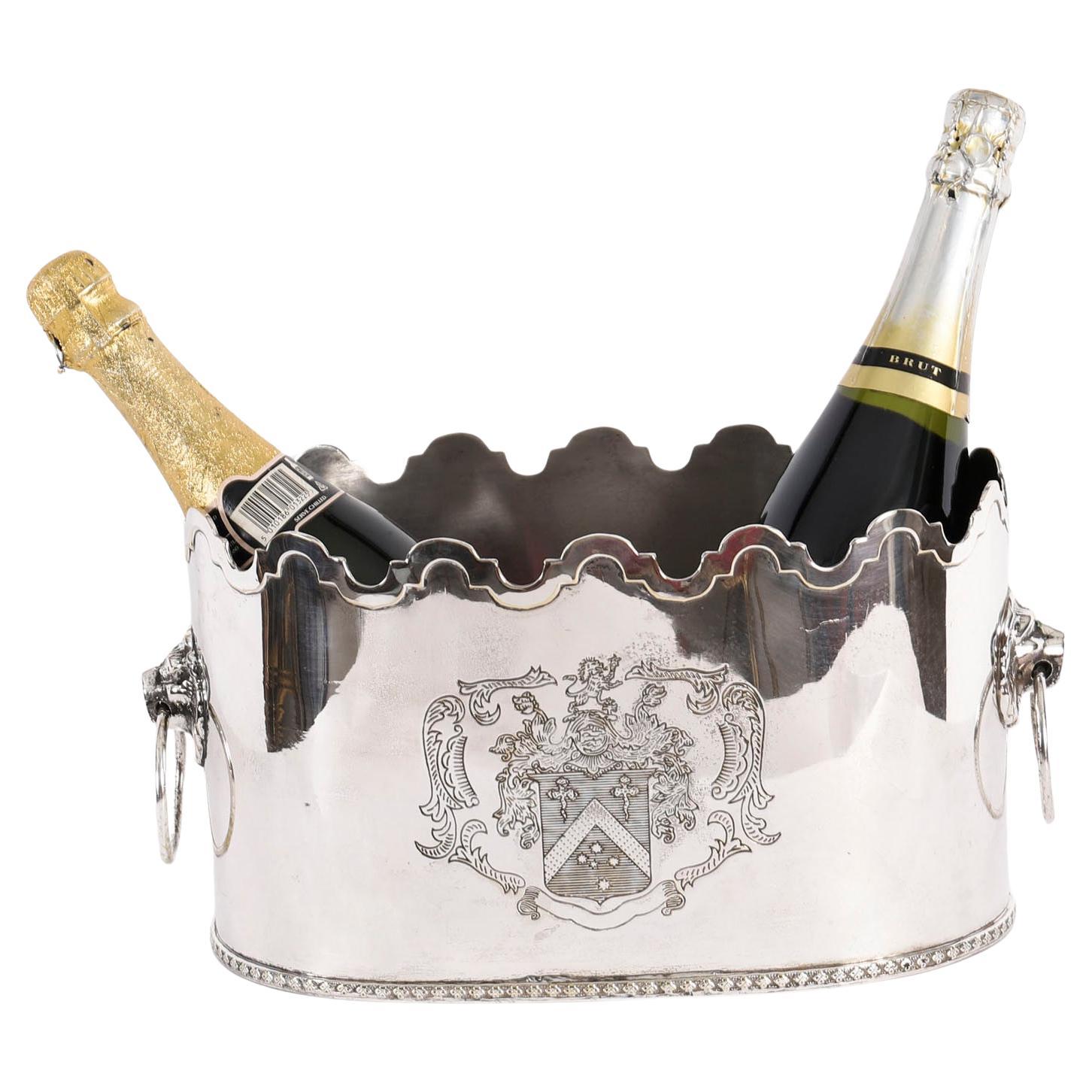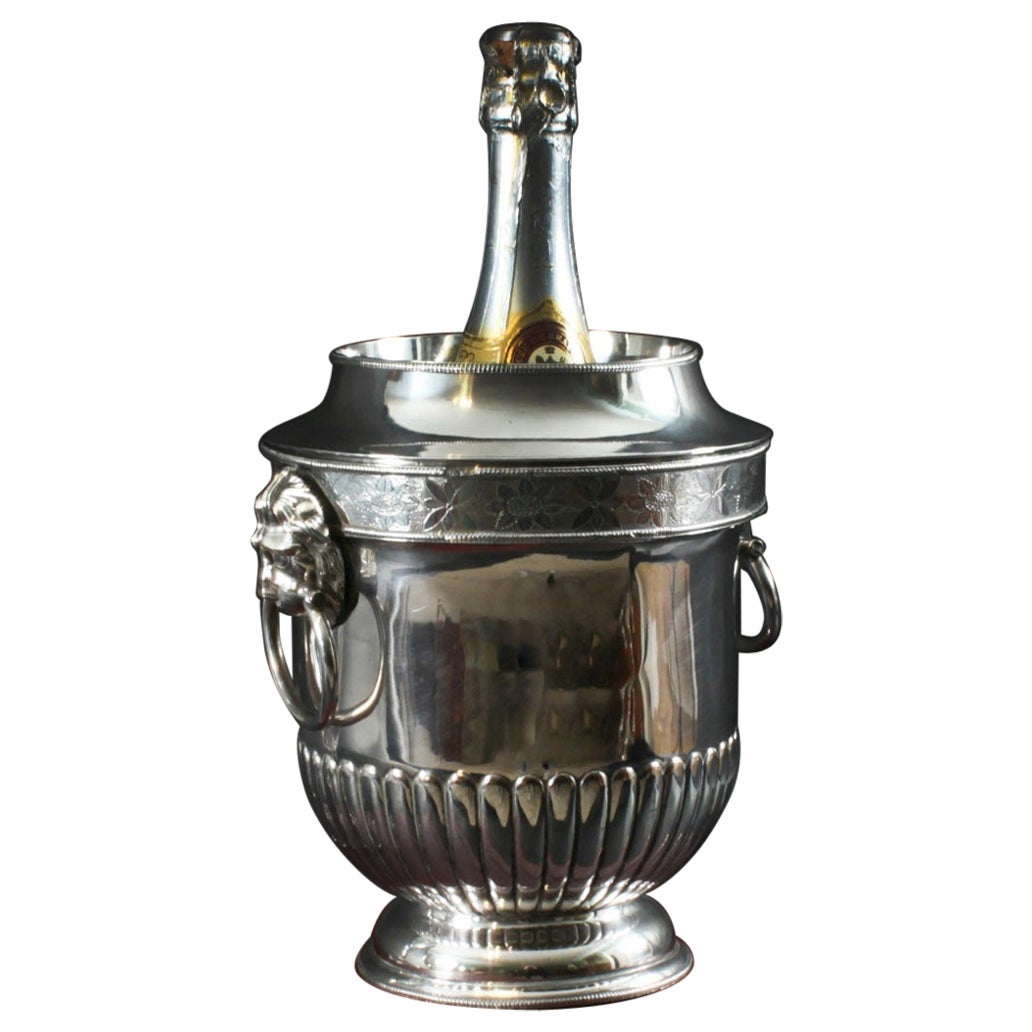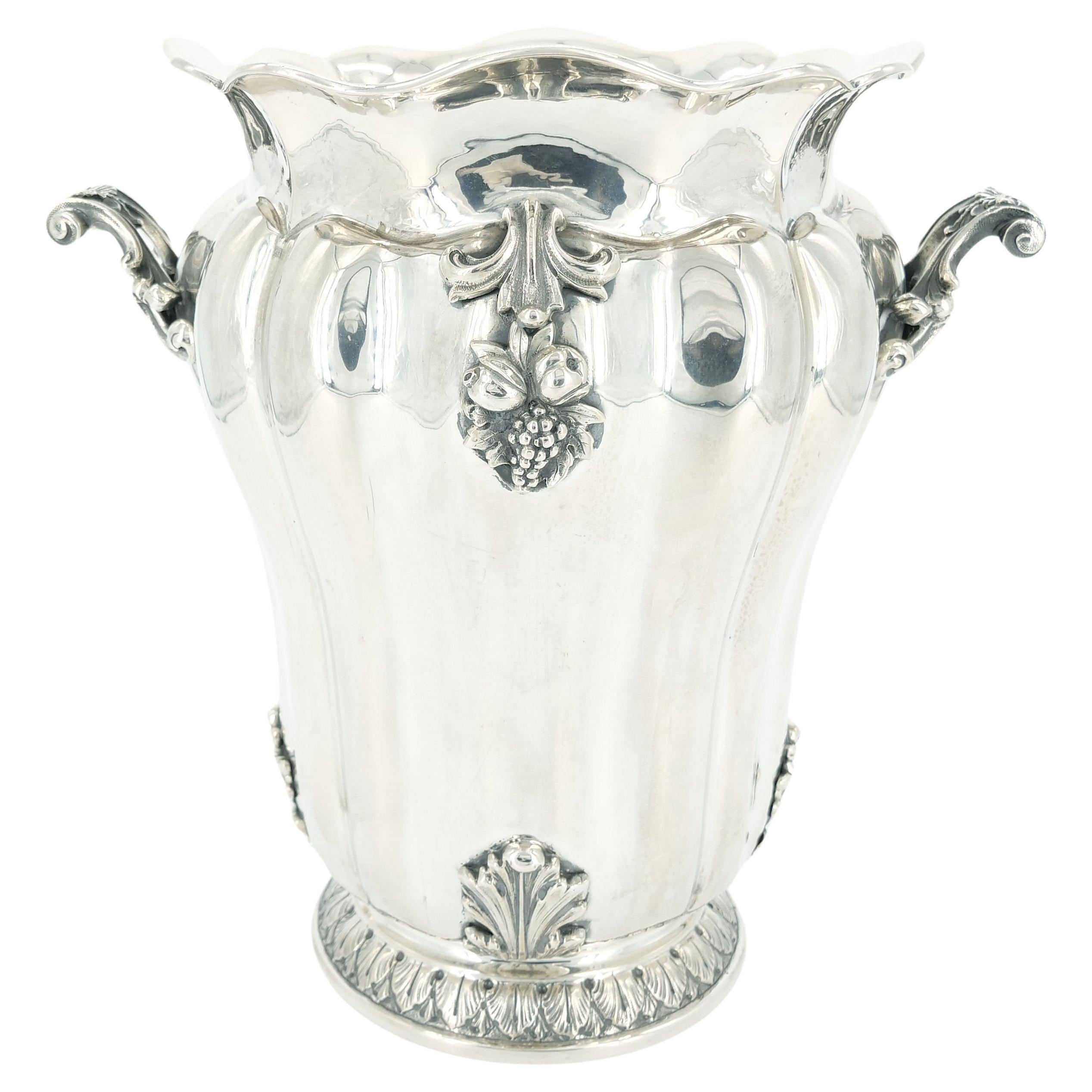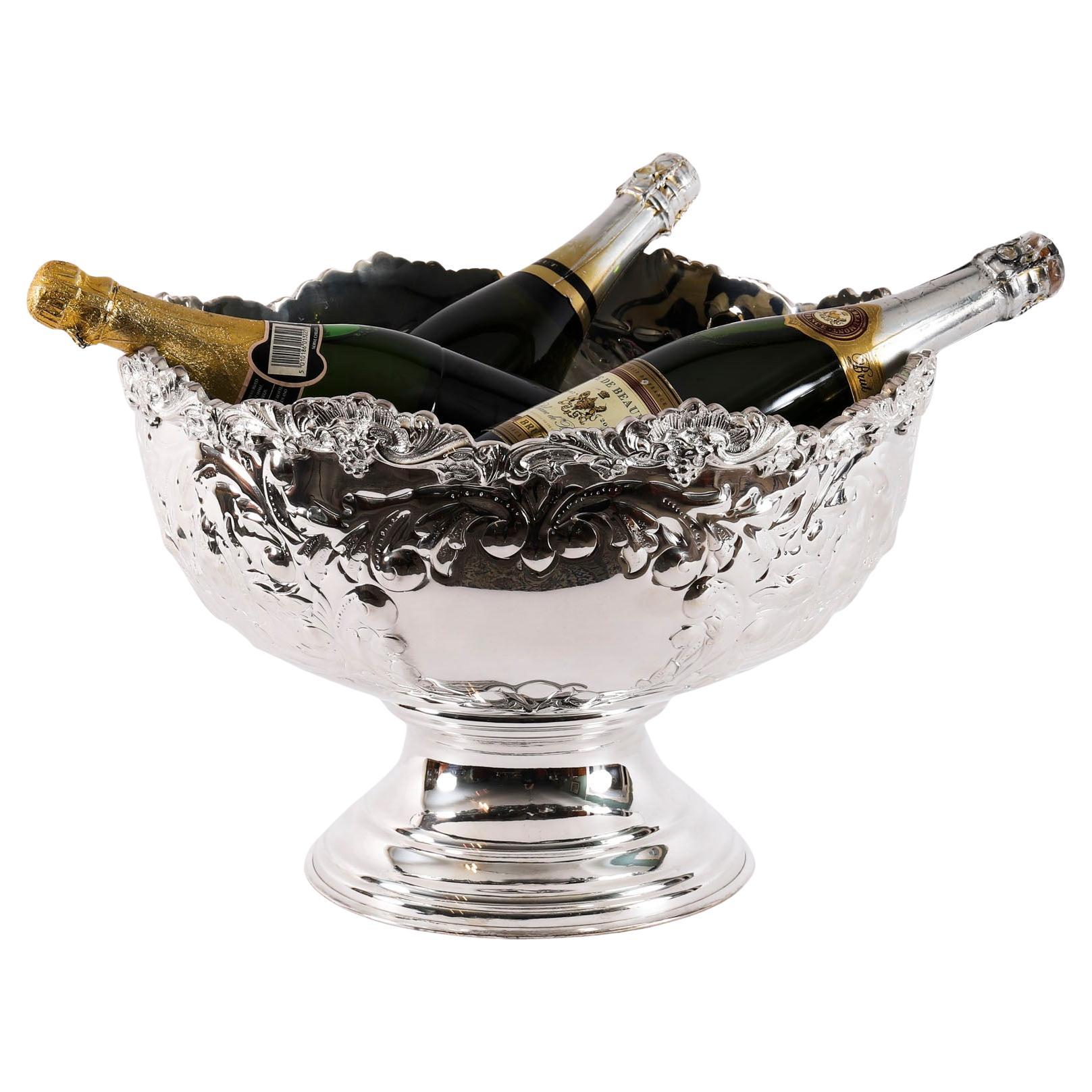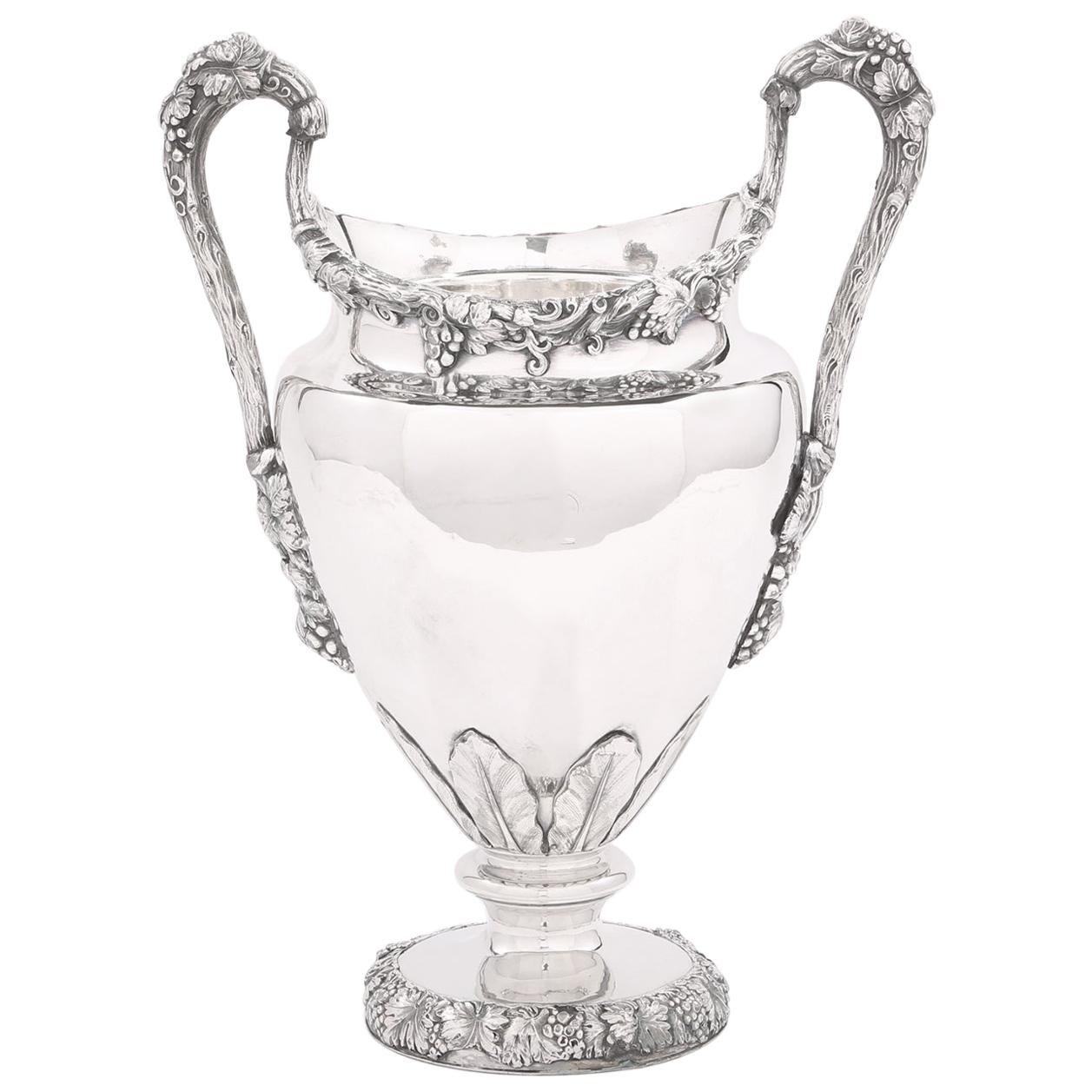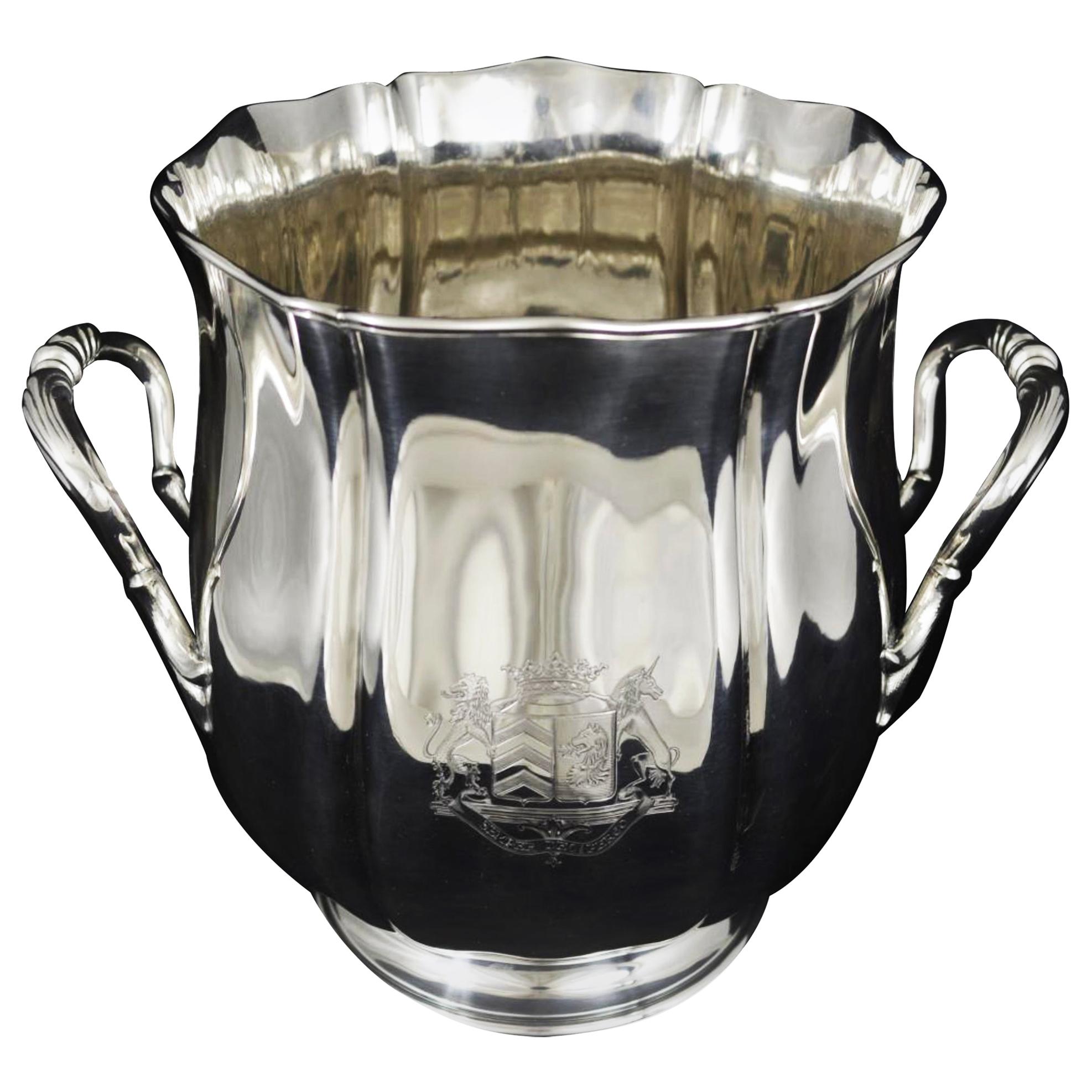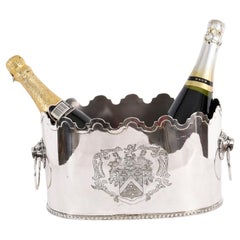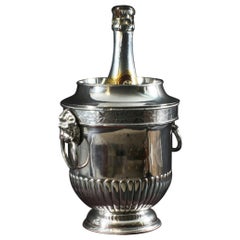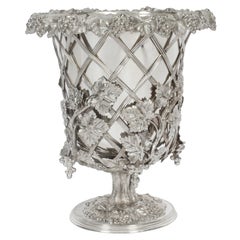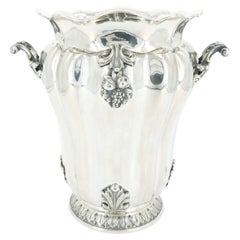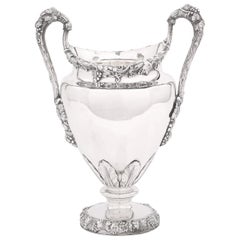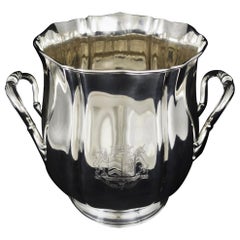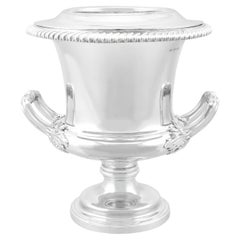Articoli simili a Antique "1st Lancashire Rifle" Silver Plated Wine Cooler Elkington 19th Century
Caricamento del video
Vuoi altre immagini o video?
Richiedi altre immagini o video al venditore
1 di 18
Antique "1st Lancashire Rifle" Silver Plated Wine Cooler Elkington 19th Century
1271,69 €
Informazioni sull’articolo
This is an exceptional antique English Neo-classical Revival silver plated wine cooler bearing the makers mark of the renowned English silversmith Elkington, dated 1873.
The wine cooler is raised on a circular pedestal base with a reeded body and decorative lion head handles. It has an engraved cartouche with the inscription
'Presented to the 1st Lancashire Rifle Volunteers
by Lt Colonel Bousfield 1882'.
Bousfield is regarded as one of the founders of what eventually became the Territorial Army.
Add some classical elegance to your home with this lovely decorative cooler.
Condition:
In excellent original condition. As an antique item, the cooler shows minor signs of use commensurate with age, these minor condition issues are mentioned for accuracy and, as seen in the accompanying photographs, it displays beautifully.
Dimensions in cm:
Height 23 cm x Width 38 cm x Depth 38 cm
Dimensions in inches:
Height 9 inches x Width 1 foot, 3 inches x Depth 1 foot, 3 inches
1st Lancashire Rifle Volunteers
The Volunteer movement had its origins in the eighteenth century. Service in the Militia was compulsory at that time for those selected by ballot and who were not wealthy enough to hire a substitute. But specific threats, such as Jacobite risings or the threat of French invasion, induced men to volunteer for home defence. A series of Militia Acts, notably in 1761, 1768 and 1802, had the effect of transforming the Militia from a home defence force into a reserve for the Regular Army, and its former function was increasingly filled by the Volunteers.
Revolutionary and Napoleonic Wars 1793-1815 In 1794, the risk of invasion by Revolutionary France persuaded the government to authorise the formation of volunteer units that would be subject to military discipline and eligible for pay when called out. Numerous Volunteer units were formed in Lancashire including the Warrington Bluebacks, regarded (in sentiment if not in direct lineage) as forebears of 4th Battalion The South Lancashire Regiment, and the Royal Preston Volunteers. Such units and their successors from 1808 onwards, the Local Militia, usually trained on a Sunday and from time to time did duty in various towns of Lancashire and Cheshire. British Volunteer strength peaked in 1803 at a remarkable total of some 440,000, but with the defeat of Napoleon they were all disbanded.
Riflemen Form In 1859 a scare a war with France swept the country, exposing the inability of the small peacetime Regular Army to defend Great Britain as well as the vast colonial Empire. The widespread popular demand for additional volunteer forces did not at first find favour with the Government of the day, but the Ministry finally gave way and on 25 May 1859 sanctioned the formation of corps of Rifle Volunteers. Lancashire responded with particular enthusiasm to the call for volunteers and by the end of 1860 over seventy local Infantry units had been raised. Uniforms, equipment, drill halls, rifle ranges, instructors and most weapons were initially provided at private expense or by public subscription, and the Volunteers were unpaid. Within twelve months some 130,000 men were under arms in Rifle Volunteer units. From 1861 the smaller corps were absorbed by their larger neighbours to form Administrative Battalions.
Elkington & Co
was a silver manufacturer from Birmingham, England.
The firm was founded by George Richards Elkington and his brother, Henry Elkington, in the 1830s. It operated under the name G. R. Elkington & Co. until 1842, when a third partner, Josiah Mason, joined the firm. It operated as Elkington, Mason, & Co. until 1861, when the partnership with Mason was terminated. The firm operated independently as Elkington & Co. from 1861 until 1963. It was then taken over by British Silverware, Ltd. In 1971 British Silverware, Ltd. became a subsidiary of Delta Metal Co. Ltd.
Over the course of history it became very successful and was one of the prime producers of silver plating. Elkington received various royal warrants of appointments. One of their most famous pieces is the electrotype copy of the Jerningham Wine Cooler, at the Victoria & Albert Museum.
Our reference: A3838b
- Dimensioni:Altezza: 23 cm (9,06 in)Larghezza: 38 cm (14,97 in)Profondità: 38 cm (14,97 in)
- Stile:Revival (Nello stile di)
- Materiali e tecniche:
- Periodo:
- Data di produzione:circa 1873
- Condizioni:
- Località del venditore:London, GB
- Numero di riferimento:Venditore: A3838b1stDibs: LU950645322042
Informazioni sul venditore
5,0
Venditore Platino
Venditori Premium con valutazione 4.7+ e tempi di risposta entro 24 ore
Fondazione nel 1983
Venditore 1stDibs dal 2012
1381 vendite su 1stDibs
Tempo di risposta standard: <1 ora
Associazioni
LAPADA - The Association of Arts & Antiques Dealers
- SpedizioneRecupero del preventivo…Spedizione da: London, Regno Unito
- Politica di reso
Alcune parti di questa pagina sono state tradotte automaticamente. 1stDibs non può garantire che le traduzioni siano corrette. L’inglese è la lingua predefinita del sito.
Garanzia di autenticità
Nell’improbabile caso in cui si verifichi un problema con l’autenticità di un articolo, contattaci entro un anno per ottenere un rimborso completo. DettagliGaranzia di rimborso
Se il tuo articolo non corrisponde alla descrizione, è danneggiato durante il trasporto o non arriva, contattaci entro 7 giorni per un rimborso completo. DettagliAnnullamento entro 24 ore
Hai un periodo di tolleranza di 24 ore per annullare il tuo acquisto, senza necessità di fornire spiegazioni.Venditori professionali selezionati
I nostri venditori di livello internazionale devono aderire a rigorosi standard di servizio e qualità, garantendo l’integrità delle inserzioni.Garanzia miglior prezzo
Se scopri che un venditore ha pubblicato altrove lo stesso articolo a un prezzo più basso, applicheremo lo stesso prezzo.Consegna globale affidabile
La nostra rete di vettori leader del settore offre opzioni di spedizione specializzate in tutto il mondo, inclusa la consegna personalizzata.Altro da questo venditore
Mostra tuttoAntico refrigeratore per vino edoardiano in argento del XX secolo
Si tratta di un magnifico eduardiano refrigeratore per vino in rame e lastra d'argento, datato circa 1910.
Questo dispenser di forma ovale presenta un bellissimo bordo sagomato con...
Categoria
Inizio XX secolo, Edoardiano, Glacette vino
Materiali
Placcato argento, Rame
Antico frigorifero per vino e champagne in argento di Giorgio III dell'inizio del XIX secolo
Un antico e superbo dispenser per vino e champagne di George III Old Sheffield, datato circa 1810.
Questo dispenser estremamente versatile presenta il marchio "argento su rame" di S...
Categoria
Di antiquariato/d’epoca, Anni 1810, Inglese, Giorgio III, Glacette vino
Materiali
Argento
A. Silver, grande dispenser di champagne placcato d'argento / Punch Bowl del 20° secolo
Si tratta di uno splendido e grande dispenser per champagne d'epoca placcato in argento che può contenere oltre 6 bottiglie, risalente alla fine del XX secolo.
Questa squisita cioto...
Categoria
Fine XX secolo, Accessori Sheffield e placcati in argento
Materiali
Placcato argento
Antico refrigeratore di vino Regency con piatto Sheffield del XIX secolo
Si tratta di un meraviglioso, raro e altamente decorativo antico frigorifero da vino inglese Old Sheffield Plate Regency di forma campana, datato circa 1820.
È impreziosito da un...
Categoria
Di antiquariato/d’epoca, Anni 1820, Inglese, Regency, Accessori Sheffiel...
Materiali
Sheffield
Antico frigorifero per vino e champagne in cristallo tagliato della Reggenza inglese del XIX secolo
Si tratta di un raffinato e antico dispenser per vino e champagne in cristallo tagliato di epoca Regency, datato circa 1810.
Presenta un vetro tagliato pesante con bordo estrofless...
Categoria
Di antiquariato/d’epoca, Inizio XIX secolo, Inglese, Regency, Glacette vino
Materiali
Cristallo
Antico refrigeratore per vino di George III di Matthew Boulton con stemma Robinson 18° C.
Si tratta di un elegante secchiello per ghiaccio o vino in rame, datato circa 1790 e recante i marchi di Matthew Boulton, argentiere di fama mondiale.
Il dispenser ha una forma a ba...
Categoria
Di antiquariato/d’epoca, Anni 1790, Glacette vino
Materiali
Placcato argento
Ti potrebbe interessare anche
Raffreddatore per vino / secchiello per il ghiaccio in argento sterling del XIX secolo
Trasportati nell'opulenza del 19° secolo con questo refrigeratore per vino o secchiello per il ghiaccio in argento sterling, un vero capolavoro di design e artigianato. Questo eccezi...
Categoria
Di antiquariato/d’epoca, Anni 1820, Italiano, Georgiano, Articoli da bar
Materiali
Argento 925
Raffreddatore per vino vittoriano in argento molto raffinato
Raffreddatore per vino in argento in stile vittoriano, con dettagli esterni a motivo di vite e maniglie laterali e rivestimento interno rimovibile. Il dispenser è in buone condizioni...
Categoria
Di antiquariato/d’epoca, Anni 1830, Inglese, Vittoriano, Glacette vino
Materiali
Placcato argento, Rame
Magnum Wine Cooler o secchiello per champagne in stile Luigi XV con argento massiccio
Questo elegante secchiello per champagne a forma di tulipano si adatta a una magnum, è appoggiato su una bacheca sagomata, il cui bordo è delineato da filettature bypassate. Decorazi...
Categoria
Inizio XX secolo, Italiano, Luigi XV, Argento 925
Materiali
Argento
Antico refrigeratore di vino inglese vittoriano in argento sterling
Di John Watson & Son
Un eccezionale, raffinato e imponente dispenser da vino in argento inglese di epoca vittoriana; un'aggiunta alla nostra collezione di argenteria antica dedicata al vino e alle bevand...
Categoria
Di antiquariato/d’epoca, Anni 1830, Inglese, Vittoriano, Articoli da bar
Materiali
Argento 925
Secchiello da vino per champagne placcato in argento di Henry Hicks, di epoca vittoriana.
Antico secchiello da vino per champagne placcato in argento Henry Hicks con monogramma "S". Circa metà del XX secolo. Misure: 8" H. x 9,5" W. x 7" D.
Categoria
Metà XX secolo, Sconosciuto, Vittoriano, Articoli da bar
Materiali
Placcato argento
Raffreddatore per vino champagne in argento di Walter and John Barnard, Londra, 1889
Di Walter and John Barnard
A. Silver splendido Champagne & Refrigeratore per vini d'annata (ultimo quarto del XIX secolo) di aspetto raffinato
____________________________________________________________...
Categoria
Di antiquariato/d’epoca, Anni 1880, Britannico, Vittoriano, Argento 925
Materiali
Argento
